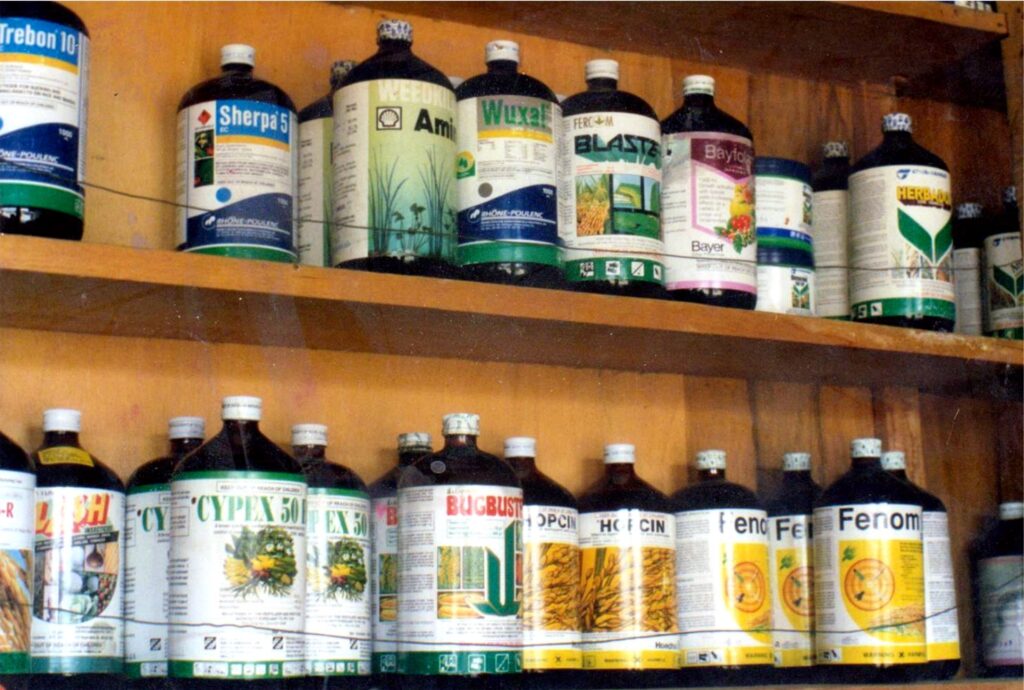Text and Photos by Henrylito D. Tacio
“Pesticides are like bombs being dropped in the food web creating enormous destruction,” said Dr. K. L. Heong, an entomologist who once worked with the Laguna-based International Rice Research Institute.
The Rome-based Food and Agriculture Organization (FAO) estimates that up to 35 percent of the losses in annual crop production worldwide are due to pests – insects, weeds, plant diseases, rodents, and birds. Of the estimated one million insects in the world, between 150 to 200 species frequently cause serious damage to crops.
When losses due to pests are combined together with post-harvest losses, worldwide food losses would amount to 45 percent. “This is almost one half of the world’s potential food supply,” the United Nations food agency surmised.
To annihilate pests, most farmers use pesticides. The Fertilizer and Pesticides Authority defines a pesticide as “any substance or mixture of substances intended for preventing, destroying, repelling, or mitigating any insects, rodents, nematodes, fungi or weeds, or any other form of life declared to be pest.” It also refers to “any substance or mixture of substances intended for use as a plant regulator, defoliant, or desiccant.”
Pesticides are classified according to their degree of danger. The pesticide’s label should give a warning notice in the shape of a symbol. Skull and crossbones on the label means that the pesticide is extremely or highly toxic. A highly toxic pesticide may be lethal when an adult ingests less than a teaspoon.

Pesticide-free fruits 
Are these crops free from pesticides
The first records of pesticides come from the ancient Greeks. Pliny the Elder compiled a list of common compounds like arsenic, sulfur, caustic soda, and olive oil used to protect crops. The Chinese later recorded using similar substances to combat insects and fungi. In the 19th century, European farmers started using heavy metal salts like copper sulfate and iron sulfate to fight weeds.
“With the invention of DDT in 1939, the war against pests escalated sharply,” notes Peter Weber of the Washington-based Worldwatch Institute (WWI). “This new synthetic made earlier pesticides appear crude and dangerous.”
DDT (dichloro-diphenyl-trichloroethane) was effective, relatively, and apparently safe for people – a miracle chemical. Swiss Paul Muller, who discovered DDT, got a Nobel Prize for it.
Under the stream of new pesticides, scientists reported unprecedented crop yields. Farmers began using pesticides intensively in industrial countries and, when money allowed, everywhere else. The notion that pesticides are essential to modern, high-production agriculture was born.
For a long time, no one seemed to question the safety of pesticides. Not until 1962, when marine biologists and writer Rachel Carson wrote the now-classic Silent Spring. In her book, she described how pesticides cause long-term hazards to birds, fish, other wildlife, and humans but provides only short-term gains to controlling the pests.
Unknowingly, pesticides are killing more than just pests. “Some pesticides harm the living organisms other than the targeted pests,” noted the Davao-based Technical Assistance Center for the Development of Rural and Urban Poor. “Some travel to the food chain to bioaccumulate in higher organisms.”
In their book, Pesticides and You, Gretta Goldenman and Sarojini Rengam explain that pesticides are concentrated even to toxic levels via the food chain. Thus, an increased feeding on plants sprayed with pesticides might be eaten by another insect which might be eaten by a bird. “Traces of pesticides too small to kill the targeted pest can accumulate to levels high enough to harm species further on up the food chain,” the authors warn.
Health experts claim pesticides can enter the human body through the lungs, digestive system, or skin. Depending on the kind of pesticide, health effects can be immediate (acute), or they can occur after years of low-level exposure.
Generally, acute poisoning occurs after an accident, such as pilling a bottle of pesticide on the skin or drinking from a bottle containing pesticides. The symptoms of acute poisoning occur within 24 hours: vomiting, headache, respiratory problems, and heart failure, among others.
Long-term effects of pesticides include skin disorders, damage to internal organs (particularly liver, kidneys, and lungs), increased sensitivity to pesticides, and effects on the progeny.
The Geneva-based World Health Organization (WHO) reports that three people are poisoned by pesticides every minute around the world. All in all, about 10,000 die annually to pesticides.
Dr. Susan Cooper, an ecologist with the National Coalition Against the Misuse of Pesticides, contends that scientists still hardly understand the effects of exposure to one chemical, and they have little idea what happens when people are exposed to many. “The risks could be worse than we think,” she said.
Dr. Romeo F. Quijano, a professor at the University of the Philippines College of Medicine, reports that “certain pesticides can disrupt the human endocrine system, which includes the glands that control the release of hormones in our bodies.” He adds that there are also pesticides that can actually “mimic” hormones found in the human body.
One of the more serious long-term effects of pesticides on people’s health is cancer. “Several pesticides are already known to cause cancer in humans,” Dr. Quijano states. “Others may not have direct evidence of causation but have shown to be associated with increased cancer incidence. Many others have been shown to cause cancer in animals but evidence of causation in humans is non-conclusive or lacking.”
But people are not the only beings affected. Even the friendly bugs are annihilated. Take the case of bees, those flying insects closely related to wasps and ants. They are known for their role in pollination and for producing honey and beeswax. A 2011 United Nations report estimates that bees and other pollinators do work worth US$203 billion a year to the human economy.

Despite their importance, they are now disappearing in various parts of the world, according to some European scientists. In two studies published in the journal Science, British and French researchers fear that pesticides are destroying bee populations.
“In North America, several bumblebee species which used to be common have more or less disappeared from the entire continent,” said Dave Goulson of Stirling University in Scotland. In Britain, three species have become extinct.
Despite all these ill effects they brought, the use of pesticides continues unabated. “The health hazards associated with pesticide use have been known for years and the extent of harm they cause has increased, yet, chemical companies keep on pouring millions of tons of pesticides annually into the world’s biosphere,” deplores Quijano.
Many Filipino farmers believe that if they should not use pesticides, their harvests would plummet, and more people would go hungry. It is widely assumed that for big harvests, pesticides are essential. After all, it is noted, farmers in industrialized countries apply more pesticides, lose less to pests, and reap higher yields than farmers in developing countries.
A closer look at the data, however, indicates that pesticides are not as essential as many people think, according to the Laguna-based International Rice Research Institute (IRRI).
An IRRI study on the effects of pesticides on rice productivity and health shows that farmers’ earnings from chemically-treated crops are often greatly reduced by the cost of treating pesticide-related health problems.
“The value of the crops lost to pests is invariably lower than the expense of treating pesticide-caused ailments,” IRRI said in a statement. “When health costs are factored, the use of correct rice varieties and reliance on natural control by predators and parasites is the least expensive pest control strategy.”
Here’s a bad news. Some pesticides are losing their effectiveness against crop-destroying pests as a result of so-called “genetic selection,” according to WWI.
At least 520 insects and mites, 150 plant diseases, and 113 weeds have developed resistance to one or more pesticides meant to control them. In addition, at least 17 insect species are resistant to all major classes of insecticides, and several plant diseases are immune to most fungicides used against them.
“Resistance to pesticides is as natural as evolution,” reminds Weber. “In fact, it is natural selection, in fast-forward, that provoked the very chemicals meant to control the pest. Resistant strains develop particularly quickly when farmers overuse pesticides and try to eliminate pests rather than control them. Kill 99.9 percent of the insects in a field, and the survivors are a superstrain.”

